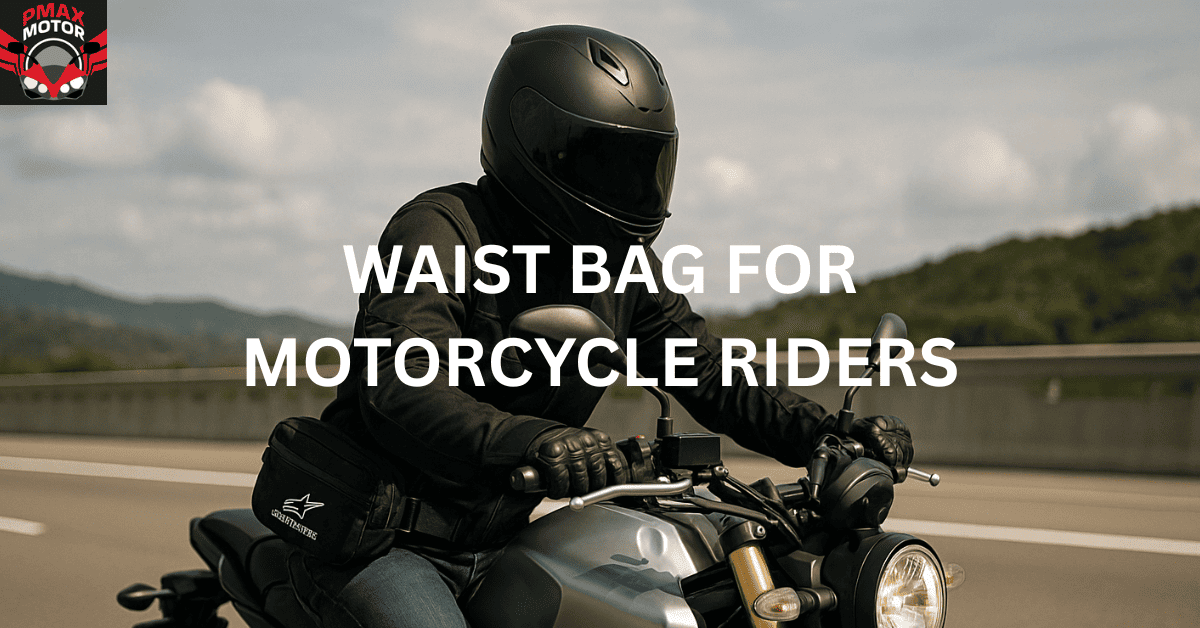No products in the cart.
Waist Bags for Motorcycle Riders: What They’re Used For
Waist bags are a lightweight, hands-free way for riders to carry essentials without overloading their pockets or backpacks.
Unlike bulky backpacks, a waist bag sits closer to your body, making it easier to access cash, keys, documents, or even a phone without dismounting. Whether worn around the waist, crossbody, or under a riding jacket, these compact bags offer function without fuss.
But convenience and let’s be honest, style! We’ll explore why waist bags make sense for riders, what you can realistically carry and the features that matter most on Malaysian roads.
Table of Contents
ToggleWhy Do Motorcycle Riders Use Waist Bags?
For short rides, city commutes, or food delivery shifts, carrying a backpack can feel excessive or uncomfortable. A waist bag solves this by offering just enough storage for your daily carry, without shifting weight across your shoulders or back.
Common reasons riders choose waist bags:
- Quick access to toll cards, keys, or cash without removing gloves
- Less heat buildup compared to wearing a backpack in Malaysia’s weather
- Lower risk of snatching or theft when worn crossbody and under a jacket
- No interference with riding posture or pillion seat space
Whether you’re heading out for errands or doing a Grab delivery run, a well-placed waist bag gives you mobility without compromise.
Items You can Carry on a Waist Bag While Riding
Waist bags are ideal for small, high-priority items that riders need on hand, without digging through a larger bag.
Unlike a backpack or pannier, a waist bag is meant for quick access, not bulk storage. It’s where you stash items you’ll use frequently or need to reach easily without removing your gear.
Common rider essentials that fit in a waist bag:
- IC, license, and toll card (Touch ‘n Go or RFID backup)
- Cash and coins for petrol or roadside stalls
- Phone and power bank
- Small tools like an Allen key or tyre pressure gauge
- Glove liners, wet wipes, or compact sunscreen
Many Malaysian riders also carry a rain hood or foldable mask for unexpected weather.
Tip: If you carry your phone or documents, choose a waist bag with inner compartments and waterproof lining for added protection.
How Should You Wear a Waist Bag While Riding?
The safest and most comfortable way to wear a waist bag while riding is crossbody, under or over your jacket.
While waist bags are designed to sit at the waist, motorcyclists often adapt how they wear them for better security, mobility, and airflow.
Recommended wearing styles for riders:
- Crossbody, front-facing (under jacket):
Keeps your bag secure and protected from snatching or rain. - Crossbody, back-facing (over jacket):
Good for longer rides if quick access isn’t a priority. Distributes weight well. - Around the waist (over riding pants):
Works for short trips, but can interfere with crouch or leaning position if too bulky.
“Always adjust straps snugly to prevent movement at high speeds. Loose bags can flap or slide, distracting you while riding.”
Pro tip: Choose waist bags with adjustable straps, slim profiles, and padded backing to avoid pressure points.
Are Waist Bags Safe for Motorcycle Use?
Unlike backpacks, which can shift your centre of gravity or cause strain during long rides, waist bags sit closer to the body. This reduces drag and improves comfort, especially during urban or mid-range commutes.
Safety considerations when using a waist bag:
- Avoid overpacking: Heavy items can shift and cause discomfort or imbalance
- Use secure zippers and compartments: Open pouches risk items falling out mid-ride
- Wear it under your jacket if possible: Protects against theft and weather
- Position the bag carefully: Avoid placing it where it may press into your stomach or spine if you fall
“While waist bags are not a replacement for full touring luggage, they offer a safer and more ergonomic alternative for light, everyday use.” – PMAX Sales Team
What Features Should You Look for in a Rider-Friendly Waist Bag?
Not all waist bags are built for riding, choose one designed for movement, weather, and daily use.
Riders need bags that stay secure, hold up against rain, and offer smart organisation. Style matters, but safety and function come first when you’re commuting or navigating Malaysian roads.
Key features to consider:
- Water-resistant or waterproof fabric
Essential for sudden rain. Look for materials like nylon, polyester, or PU-coated fabric. - Multiple compartments
Helps separate items like keys, phone, and tools to prevent scratches or bulk shifting. - Adjustable straps with quick-release clips
Allows you to tighten or reposition the bag based on your riding gear. - Low-profile or slim design
Reduces drag and keeps the bag from bulging under your jacket. - Anti-theft zippers or hidden pockets
Protects your valuables in high-traffic or stoplight situations.
For Malaysian riders, breathability and ease of drying are also important. Bags that trap heat or stay damp can cause discomfort.
Tip: Always test strap length while wearing your riding jacket to ensure a snug fit.
Waist Bag vs Backpack: Which One’s Better for Riders?
Waist bags are ideal for light daily use, while backpacks offer more space for long-distance rides.
Feature | Waist Bag | Backpack |
Storage Capacity | Low: for essentials only | High: fits laptops, tools, rain gear |
Comfort in Heat | Excellent: minimal sweat buildup | Poor: traps heat and moisture |
Accessibility | Easy: quick access to cash, cards, phone | Slower: must stop and remove to access items |
Ride Suitability | Best for short rides, daily commutes | Ideal for touring, delivery, long-distance travel |
Safety | Low profile, less interference with posture | Can shift centre of gravity or press against spine |
Wear Style | Worn around waist or crossbody | Worn on shoulders, may interfere with jacket vents |
Summary: Riders often use waist bags for short trips and backpacks for longer, gear-heavy rides. Choosing the right one depends on your distance, weather, and load.
Recommended Rider Waist Bags: Alpinestars Collection at Pmax
If you’re looking for rider-approved waist bags, offer some of the best combinations of durability, style, and utility.
At Pmax, we stock several models trusted by Malaysian riders for daily use and touring. All models are compact, water-resistant, and designed with riding posture in mind.
Model | Best For | Key Features | Price (RM) |
Alpinestars TechTool Pack Waist Bag | Urban commuting & tools | Tool sleeves, slim profile, rugged zippers | 259.00 |
Alpinestars Motor Gear Kanga-2 Waist Bag | Delivery & short-distance rides | Multiple compartments, bold colours | 229.00 |
Alpinestars Kanga-2 Waist Bag | Weekend rides & casual use | Larger pouch size, colour options | 289.00 |
All models are available now at Pmax with official warranty and local support. Perfect for riders who need compact, secure storage without the bulk of a backpack.
Need help choosing the right waist bag? Drop by our store or message us directly, we’ll help you pick the fit that works with your riding gear.
Frequently Asked Questions About Waist Bag for Motorcyclist
Can I Wear A Waist Bag While Riding A Motorcycle In Malaysia?
Yes, as long as it’s securely strapped and doesn’t interfere with riding posture or controls. Many riders wear it crossbody or under their jacket.
What Can I Carry In A Motorcycle Waist Bag?
You can carry essentials like your IC, license, cash, Touch ‘n Go card, phone, keys, and small tools. Avoid overloading it with bulky items.
Is A Waist Bag Better Than A Backpack For Daily Riding?
For short commutes or errands, yes. Waist bags reduce sweat, improve mobility, and make it easier to access items without dismounting.
Are Alpinestars Waist Bags Waterproof?
Most Alpinestars waist bags, like the TechTool and Kanga-2 series, are made from water-resistant materials, but not fully waterproof. Use a rain cover if riding in heavy rain.
How should I clean my waist bag after riding?
Wipe down the outer shell with a damp cloth, air dry completely, and occasionally clean the inner lining with mild soap. Avoid machine washing.
Where can I buy original Alpinestars waist bags in Malaysia?
You can get them at Pmax Motor, both online and in-store. All models are SIRIM-compliant where required, rider-tested, and ready for Malaysian roads.
Tags: motorcycle jacket



